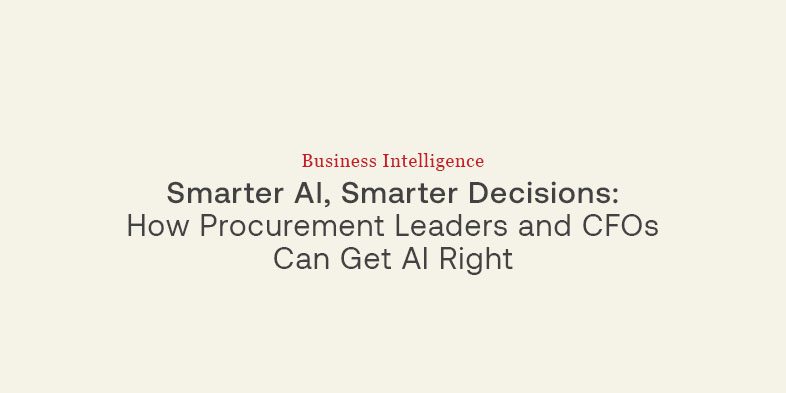Smarter AI, Smarter Decisions: How Procurement Leaders and CFOs Can Get AI Right


SpendHQ’s Pierre Laprée offers insights on how procurement leaders and CFOs can get AI right. This article originally appeared on Solutions Review’s Insight Jam, an enterprise IT community enabling the human conversation on AI.
Artificial intelligence (AI) has been at the forefront of procurement transformation for years, promising to revolutionize spend management, supplier risk assessment, and cost optimization. Over 90 percent of CPOs were planning or actively assessing AI adoption in 2024. Yet, many procurement teams struggle to extract real business value from AI investments.
The reason? Flawed or incomplete data undermines AI’s effectiveness leading to misguided decisions and missed savings. AI is only as good as the data it processes, and too often, procurement teams attempt to deploy AI solutions without ensuring their data is clean, structured, and purposefully managed. The result? Flawed insights, missed opportunities, and frustration over AI’s inability to deliver on its promises.
This article explores key barriers preventing AI from reaching its full potential in procurement—but more importantly, it highlights actionable strategies to fix these issues today. With the right approach, procurement teams can build a data-driven foundation that ensures AI enhances decision-making rather than introducing more complexity.
The AI Misconception
The biggest misconception about AI in procurement is that it can work around poor data quality. In reality, AI amplifies data issues–data quality and access challenges are among the biggest barriers to AI effectiveness in procurement. Procurement teams relying on AI models trained on inaccurate or incomplete data risk making misguided decisions that can negatively affect supplier relationships, compliance efforts, and cost structures.
Poor data quality isn’t just a technical issue—it’s a financial one. Every year, it costs organizations an average of $12.9 million. These costs come from inefficiencies, compliance risks, and flawed decision-making, all of which AI can exacerbate if the underlying data is unreliable.
Key data challenges that undermine AI effectiveness include:
- Fragmented and siloed spend data make it impossible to gain a holistic view of procurement activities.
- Misclassified or inconsistent supplier records, leading to inaccurate risk assessments and missed consolidation opportunities.
- Lack of real-time data, preventing AI from generating timely, actionable insights.
For procurement leaders and CFOs, this creates a critical dilemma: How can they balance AI-driven spend decisions with the need for measurable cost reductions while ensuring data integrity? When AI is built on inaccurate, siloed, or outdated data, it doesn’t just fail to deliver—it actively contributes to financial blind spots, overestimated savings, and increased supplier risk.
Procurement’s Dilemma: The Gap Between AI Hype and Procurement Reality
Sixty percent of procurement professionals see AI’s value in uncovering cost savings, but the reality is more complicated. AI is not an independent thinker—it reflects the quality of the data it processes. If that data is messy, AI-driven insights will be flawed.
For instance, AI may suggest supplier consolidation based on spend patterns, but if the data fails to account for key contract terms, volume discounts, or supplier reliability, the recommendations could do more harm than good. Similarly, AI also can’t account for supplier risk in a meaningful way. Most AI models rely heavily on historical data, but procurement requires a forward-looking approach that gives insights into shifting market conditions, evolving geopolitical risk, and fluctuating supplier financial health. If AI lacks accurate, real-time risk assessments, it will prioritize short-term cost savings over long-term supplier stability.
Another common challenge is procurement’s reliance on disparate systems that prevent AI from seeing the full picture. Many organizations operate with procurement data spread across multiple platforms that don’t integrate well, leading to blind spots in AI-driven insights. Without a complete and unified view of spend, AI’s recommendations can be limited in scope, leading to fragmented decision-making that fails to deliver real, organization-wide impact.
The CFO’s Dilemma: AI and the Bottom Line
CFOs need AI-driven insights that translate into measurable financial impact, not just vague predictions. However, many remain skeptical because they don’t trust the underlying data. In fact, 66 percent of procurement teams face pushback from finance due to concerns about data accuracy, auditability, and transparency.
To secure CFO buy-in, procurement must prioritize data integrity—ensuring AI-driven insights are accurate, auditable, and aligned with financial expectations. Strengthening AI’s reliability builds CFOs’ confidence in AI-driven decisions, ensuring that insights align with financial objectives and driving a cycle of greater efficiency, visibility, and savings.
Overcoming AI’s Data Challenges in Procurement
Procurement teams must take a structured approach to data management if they want to unlock AI’s full potential. Here’s how they can build a foundation that ensures AI enhances procurement’s financial value and decision-making instead of introducing risks:
Build a Strong Data Foundation
AI is only as good as the data it processes. Procurement teams must:
- Cleanse and standardize data by eliminating duplicates, correcting misclassifications, and ensuring supplier records are consistent.
- Implement quality checks to detect missing data points, inconsistencies, and errors before AI models process information.
- Invest in robust spend data management to maintain accuracy across procurement functions and ensure AI works with reliable inputs.
Establish Clear Data Governance
Strong governance prevents AI from operating on conflicting or outdated information. Procurement teams should:
- Assign clear ownership of data maintenance and accuracy.
- Define a single source of truth to ensure procurement, finance, and supply chain teams work from a unified dataset.
- Automate updates and conduct regular audits to maintain real-time accuracy and prevent data degradation.
Define a Sense of Purpose for AI
AI can provide insights, but only if procurement teams know what to ask. To ensure AI serves business needs, organizations must:
- Train teams on AI’s capabilities and limitations to set realistic expectations.
- Clarify business objectives before applying AI to ensure insights support cost reduction, efficiency, and compliance.
- Strengthen data literacy so teams can frame the right questions and interpret AI-driven insights effectively.
Prepare for Real-Time Data Processing
Real-time AI decisions require minimal human intervention. Procurement teams should:
- Streamline PO and invoice approvals by eliminating unnecessary manual steps that delay automation.
- Automate data ingestion and validation to reduce human error and ensure AI works with accurate, up-to-date information.
- Integrate procurement systems so AI can pull real-time spend data without manual reconciliation.
Bridge the Gap Between Procurement and Finance
AI-driven insights must support financial strategy, not just procurement operations. To ensure alignment:
- Collaborate with CFOs to validate AI-generated recommendations against financial objectives.
- Ensure AI-powered insights integrate with financial planning tools to improve visibility into cost structures and supplier performance.
The Bottom Line: AI’s Value Lies in the Data
AI can transform procurement, but only when procurement teams lay the right foundation. By cleaning, governing, and structuring their data, they can turn AI into a powerful tool that delivers real insights and cost savings.
Organizations that treat AI as a strategic asset—rather than a trendy investment—will unlock its full potential and gain a competitive advantage in procurement excellence.





























